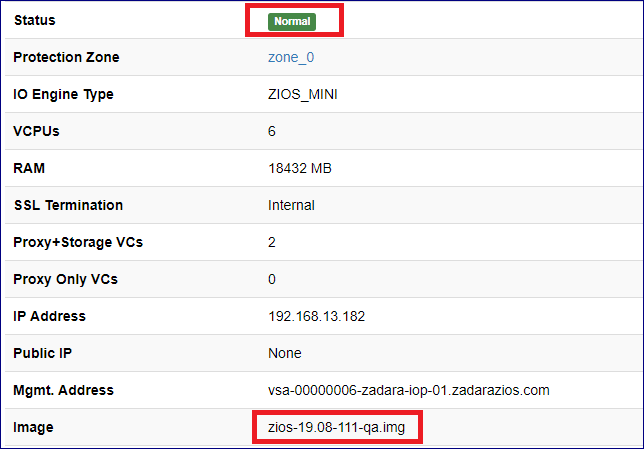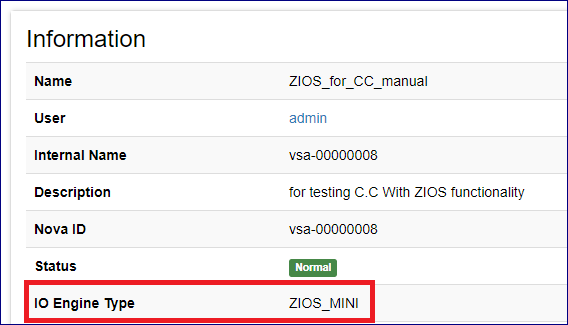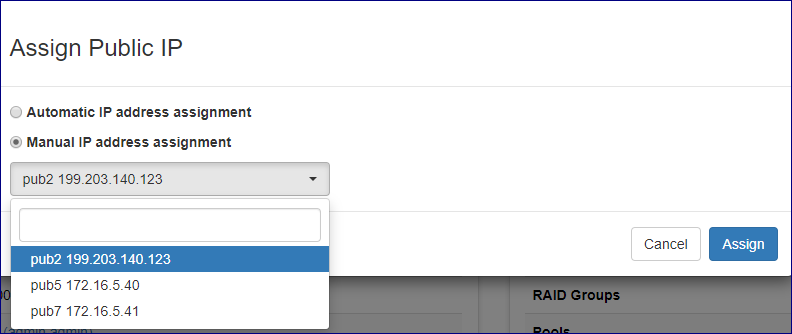Managing Object Storage VPSAs¶
Perform various management operations on VPSA object storage instances
Configure Object storage availability zones resource allocation
Monitor Object storage capacity consumption trends
Viewing Object Storage Properties¶
Object Storage properties/status can be viewed in the Object Storage Dashboard tab.
Property |
Description |
|---|---|
Name |
Instance display name |
Internal Name |
internal instance name |
Company |
Creating user company |
Description |
Description given while instance was provisioned |
Nova ID |
Nova ID for this instance |
Status |
Current Instance status |
Protection Zone |
Instance protection zone configuration |
IO Engine type |
VC type for this Object storage Mini/Standard/Premium |
VCPUs |
VCPUs per VC type (Proxy+Storage/Proxy) for this instance |
RAM |
RAM per VC type (Proxy+Storage/Proxy) for this instance |
SSL Termination |
Where does SSL termination Occur (internal/External) |
Proxy + Storage VCs |
Instance Proxy + Storage VC count |
Proxy Only VCs |
Instance Proxy only VC count |
IP Address |
Instance Floating frontend IP address |
Public IP |
Instance public IP address |
Mgmt. Address |
Instance hostname for management access |
Load Balancer |
Instance Load balancer type (Basic\Elastic Load Balancer ) |
Image |
Instance deployment image |
UUID |
Instance UUID |
SNMPv3 Engine ID |
Instance SNMPv3 EngineID |
Created |
Creation timestamp |
Updated |
Last update timestamp |
Managing Object Storage Availability Zones¶
Object storage availability zones are required to support the various protection policies used in the cloud. By default there are 4 Availability zones defined in each cloud to which different storage nodes can be allocated.
Cloud administrators ability to define specific object storage protection policies is dependent on the SN to availability zone allocation scheme.
Protection Policy |
Number of availability zones with SN allocated required |
|---|---|
2-way mirroring |
2 |
3-way mirroring |
3 |
6+3 erasure coding |
3 |
8+4 erasure coding |
3 |
9+3 erasure coding |
4 |
Assigning and removing Storage nodes to Object storage availability zones¶
To view current object storage availability zones configuration select the Object Storage tab and then on the following screen select the Object Storage Availability Zones tab. The Object Storage Availability Zones tab presents the current resource allocation scheme and amount of resources (VCPUs , Memory and Drives) is Allocated , Utilized or free in each availability Zone. On the lower part of the screen a list of available storage nodes and their resources inventory is displayed.
To allocate a Storage Node to an Availability zone:
Select a storage node and click the appropriate
Add to zonebutton on the right side of the screenOn the popup dialog that appears select the required availability zone and click
addThe availability zone configuration will update to reflect the required changes.
To remove a Storage Node from an Availability zone:
Click on required Availability zone
On the Storage nodes tab locate the node you wish to remove and click the
Removebutton
On the following popup dialog confirm the removal request
The availability zone configuration will update to reflect the required changes.
Viewing Object storage availability zones drive inventory¶
To view drive inventory click on the Zones Drives inventory tab, Inventory will be presented grouped by drive types.
Managing VPSA Object Storage Instances¶
Adding drives to VPSA object Storage¶
From the Instances tab on the Object Storage screen select the appropriate
VPSA Object storage instance. From the specific Instance dashboard click the Actions button
then select Add drives from the drop down menu.
On the popup dialog that will appear select the required protection policy, number of drives to be added
and the drive type. Click on the Add drives button, the request will be submitted.
Note
When Adding drives to VPSA Object storage virtual controllers can also be added automatically depending on the drive to VC ratio
In case that the VPSA Object Storage instance version is older then 20.01 - virtual controllers cannot be spawn on Storage Nodes with ConnectX-5 NICs
To avoid any performance impact - drive addition process is performed gradually, configuration of drive addition increments can be performed from the settings dialog in the VPSA object storage GUI. Drive addition progress can be monitored from the VPSA Object Storage Storage Policies tab in command center.
Creating a storage policy¶
From the Instances tab on the Object Storage screen select the appropriate
VPSA Object storage instance. From the specific Instance dashboard click the Actions button
then select Create Storage policy from the drop down menu.
On the popup dialog that will appear select name your new storage policy and select an appropriate protection
policy from the list of the cloud supported policies. Select the number of drives you wish to assign to your new policy and
the drive type to use. click on the create storage policy button , the request will be submitted for processing.

Adding a proxy virtual controller¶
From the Instances tab on the Object Storage screen select the appropriate
VPSA Object storage instance. From the specific Instance dashboard click the Actions button
then select Add Proxy VC from the drop down menu.
On the popup dialog that will appear confirm the operation by clicking on the Add Proxy Virtual Controller button.
The request will be submitted for processing, after completion the proxy only VCs property on the specific VPSA Object storage dashboard will be incremented.

Upgrading VPSA Object storage¶
Command center allows administrators to perform version upgrade on the VPSA Object storage instances running in the cloud.
to perform version upgrade select the appropriate VPSA Object storage instance from the Instances tab on the Object Storage screen.
From the specific Instance dashboard click the Actions button then select Upgrade from the drop down menu.
On the popup dialog that will appear select the specific image level to which h you would like to upgrade and click on the Upgrade button to confirm.

Another Pop up dialog will appear requesting confirmation for upgrading to the selected version click on the Upgrade button to confirm the process.

The request will be submitted and the VPSA Object storage status property will change to Upgrading version while the process is running.

When the VPSA version upgrade process is completed the status property will be changed back to normal and the image property will be updated to reflect the new VPSA version.

Note
From cloud version 20.12 VPSA Object Storage upgrade to a version which more then 2 major release higher then the current version will be blocked by Command Center
From cloud version 20.12 VPSA Object Storage version downgrade will be blocked by Command Center
Changing VPSA Object Storage engine type¶
When creating a VPSA Object storage with 4 disk drives or less the VPSAs engine type will be set to MINI which is a lower footprint engine compared to the fully blown VPSA for object storage virtual controller (designed to support up to 12 disk drives). VPSA for Object Storage MINI virtual controllers can be manually converted to the fully blown footprint by Command Center.

Note
VPSA Object Storage engine will be automatically upgraded when more then 4 disk drives overall are provisioned to it
To change engine type go to the appropriate object storage instance and
click the Actions button and select Change Engine Type from the drop
down menu. On the popup dialog that will appear confirm the operation by
clicking on the Change engine button. The request will be submitted for
processing. After completion the IO Engine Type property on the specific
VPSA Object storage dashboard will Changed to Standard.
Hibernate VPSA Object storage instance¶
VPSA Hibernation will take the instance offline and free its consumed resources ( vCPU , RAM ) on the Storage Nodes level. Hibernation of a VPSA will also reduce its associated service cost. For VPSA in a hibernated state only drives are billed. Hibernating a VPSA involves the process of deleting its Virtual Controllers (the VPSA) while maintaining the data drives and all the necessary metadata to resume its operation at a later stage. Resuming a hibernated VPSA only takes a few minutes.
From the Instances tab on the Object Storage screen select the appropriate VPSA Object storage instance.
From the specific Instance dashboard click the Actions button then select Hibernate from the drop down menu.
On the popup dialog that will appear confirm the operation by clicking on the Hibernate button.
The request will be submitted for processing, upon successful completion the VPSA Object storage status will change to Hibernated.
Assigning a Public IP address to VPSA object Storage¶
In specific cases where a VPSA object storage instance needs to be available for management access from outside of his Cloud allocated VLAN, a public IP address can be assigned to it. On information regarding the definition of Cloud level public IP ranges please refer to Creating Public IP addresses in this manual.
To assign a public IP address go to the appropriate object storage instance and click the Actions button
and select assign public IP from the drop down menu.

Public IP addresses can be automatically assigned from a cloud level pool or manually selected.
To automatically assign a public IP address: On the popup dialog that will appear make sure Automatic IP address assignment is selected and confirm the operation by clicking on the Confirm button.
To manually select a specific public IP address: On the popup dialog that will appear select Manual IP address assignment, select the required public IP and confirm the operation by clicking on the Confirm button.
Note
Manual public IP assignment is only available for VPSA object storage instances in version 20.01 and above
Public IP is not supported for VPSA object storage instances with IPV6 frontend address
Creating VPSA Object Storage Zsnap¶
To Trigger Manual creation of Zsnap for the VPSA Object storage go the its dashboard, click the Actions button and select Create Zsnap from the drop down menu.
On the popup dialog that will appear provide the prefix for the Zsnap and confirm weather you would like to include the VPSA Object storage metering data.
Confirm the Zsnap creation by clicking on the Create Zsnap button.





